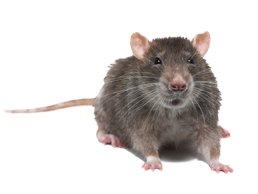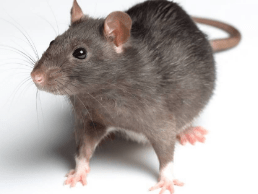Rat Removal & Info
Reviled as the most destructive mammal pest, rats compromise the well-being of humans and cause costly damage to manmade structures. They can live as long as two years in the wild and produce as many as 20 young in that span of time. Norway rats are mostly active at night, have poor eyesight, and rely on their other senses to guide them. Actually quite intelligent, Norway rats quickly detect and avoid unfamiliar objects that show up in their chosen environment, such as traps and baits. Their rapid rate of reproduction and elusive nature make them particularly challenging to control.
Biology & Behavior
The Norway rat is the common domestic rat in Utah. It has course hair, close set ears, and its muzzle is blunt. The tail is dark on top and light on the underneath side. The tail is shorter than the combined length of the head and body.The fur is grey brown on back and grey white on the belly. The adults weight between 0.12 and 0.20 ounces and the combined length of the head and body is 7.5 to 10 inches long. The tail length is between 6 and 8.5 inches. The feces are capsule shaped and about 0.75 inch long.Norway rats can be found in warehouses, farm buildings, houses, sewers, rubbish, dumps, wood piles, and building foundations. They are good climbers and they can jump 24 inches vertically. The Norway rat has relatively poor vision but keen sense of smell, touch, taste, and hearing. Long whiskers on the snout serve the sense of touch. Their home is often 100 to 200 feet.Norway rats and other domestic rodents are mainly nocturnal, but they may go about in undisturbed places during the day. They feed on virtually anything edible. Norway rats are unable to vomit, they must drink water to survive.
Noises
What Does a Norway Rat Sound Like?
Rats make a combination of squeaking, chattering, and hissing sounds. They can communicate different emotions depending on the frequency of the noise. Often, squeaks or hisses signify that a rat is afraid or in pain. Rats also chomp and grind their teeth.
Tracks

Rats establish foraging paths and rarely stray from them. As a result, tracks are often clearly visible to those who know what signs to look for. Rats produce a four-toed front and five-toed back footprint. They are mostly easily seen in muddy or dusty locations. Unfortunately, they can be confused with other footprints such as squirrels.
Another sign of rat infestation is signs of chewing close to foraging paths. The front teeth of the rat are perpetually growing. As a result, these rodents must gnaw on hard surfaces to keep their teeth at a manageable length. Rats also gnaw through wood and other unyielding surfaces in search of food sources. Rat droppings and urine stains are other indications of rat activity. They often are deposited along favored travel pathways.
Scat
Rat droppings are usually fairly easy to identify, because they will usually be found in large groupings, and if you are investigating a rat problem in the attic, they will often be stuck to the insulation. In terms of the look of the feces, rat droppings are usually brown pellets that are around half an inch long, although these are significantly bigger than the droppings of mice, which are much shorter, but are closest in shape to the rat droppings. In order to help verify your findings, look for brown smudges on the walls, which are caused by rat grease that rubs from their fur, and are found in many areas where there is rat activity.
Damage
Domestic rodents contaminate food by defecation, destroy structures by gnawing, transmit diseases, and harbors parasites hazardous to humans and animals. Some of the diseases that rodents convey to humans are plague, murine typhus, infectious jaundice, poliomyelitis, food poisoning, ratbite fever, and rabies. Physical Capabilities of Rodents The Norway rat can: Gain entrance through any opening that is larger than 0.5 inch square. Crawl horizontally on any pipe or conduit. Climb both horizontal and vertical wires. Climb the inside of vertical pipes that are 1.5 to 4 inches in diameter. Climb the outside of vertical pipes and conduits up to three inches in diameter. Climb vines, shrubs and trees or travel along telephone or power lines. Climb brick or other rough exterior walls that offer footholds. Jump vertically as much as 36 inches. Jump horizontally as much as 48 inches. Jump a gap of 8 feet and greater from an elevation of 15 feet. Drop 50 feet without being seriously injured. Burrow vertically in earth to a depth of four feet. Swim as far as 0.5 mile in open water, travel submerged through water, and travel in sewers. Gnaw through a wide variety of materials, including lead, adobe brick, cinder block, and aluminum sheeting.
Pictures
Commonly ASKED QUESTIONS?
What do you do with trapped animals?
That answer depends on the state in which you live. Each state has their own laws that dictate what we must do when it comes to controlling wildlife on your property. In some states, we can trap, transfer and release the animals. In some states we can trap the animals, but we can only release them back onto your own property. If you don’t want the animal released on your property, it must be humanely euthanized. Sometimes we don’t even need to trap the animal and a simple exclusion device (one-way door) can be installed to allow the animal to exit your home and be locked out.
How much does it cost to remove an animal?
There are a number of factors that determine pricing; location of the animal (i.e. – chimney, attic, crawl, wall void, living area), condition of the animal (i.e. – sick, aggressive, dead), location and condition of the property and time of year (i.e. – weather condition, offspring present?). Generally speaking, pricing will vary by location and species for just the animal removal and that pricing usually does not include the entry repair.
I think I have birds in my chimney, can you get them out?
The answer to that question is most likely “Yes”, but are you sure what you’re hearing is birds? Raccoons easily invade chimneys and they have their litters on the smoke shelf of fireplaces. The sounds baby raccoons make are often mistaken for birds in chimneys and removal can be difficult. The only birds that nest in chimneys are chimney swifts and they’re federally protected, so removal can’t be performed, but exclusion can be – once they depart. If you have a pre-fabricated chimney and birds fall between the cooling tubes, removal is nearly impossible.
How soon can you get here?
Office hours vary from franchise to franchise, but generally speaking, office hours are 8am – 6pm M-F and 9am – 3pm on Saturdays.
Clients Testimonials
OUR EXPERTS WILL SOLVE THEM IN NO TIME.
Have Any Pest Problems?
Navigations
Contact Information

At Critter Removers we're committed to providing you with the highest level of services and solutions to best fit your pest or critter control needs.


